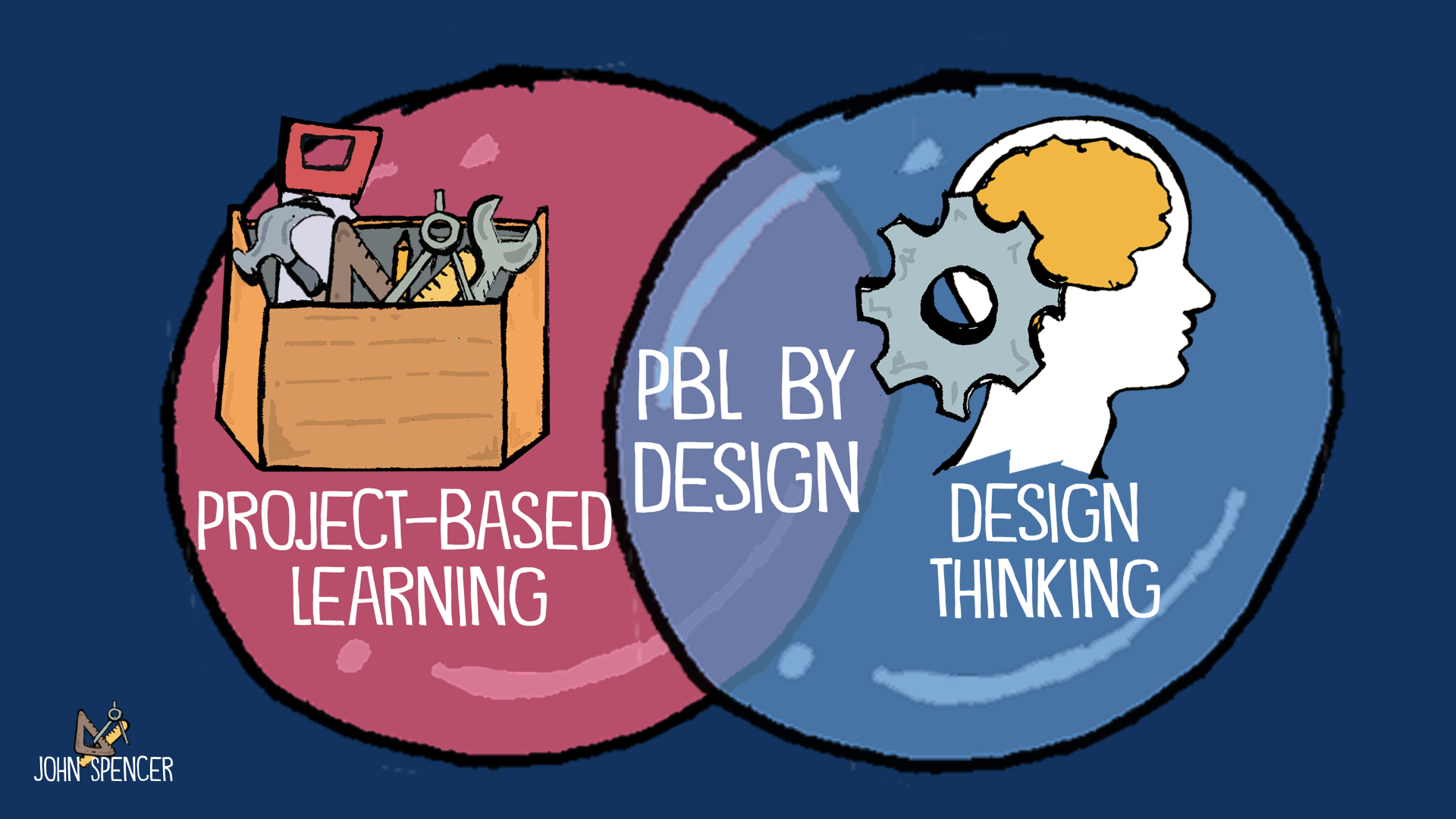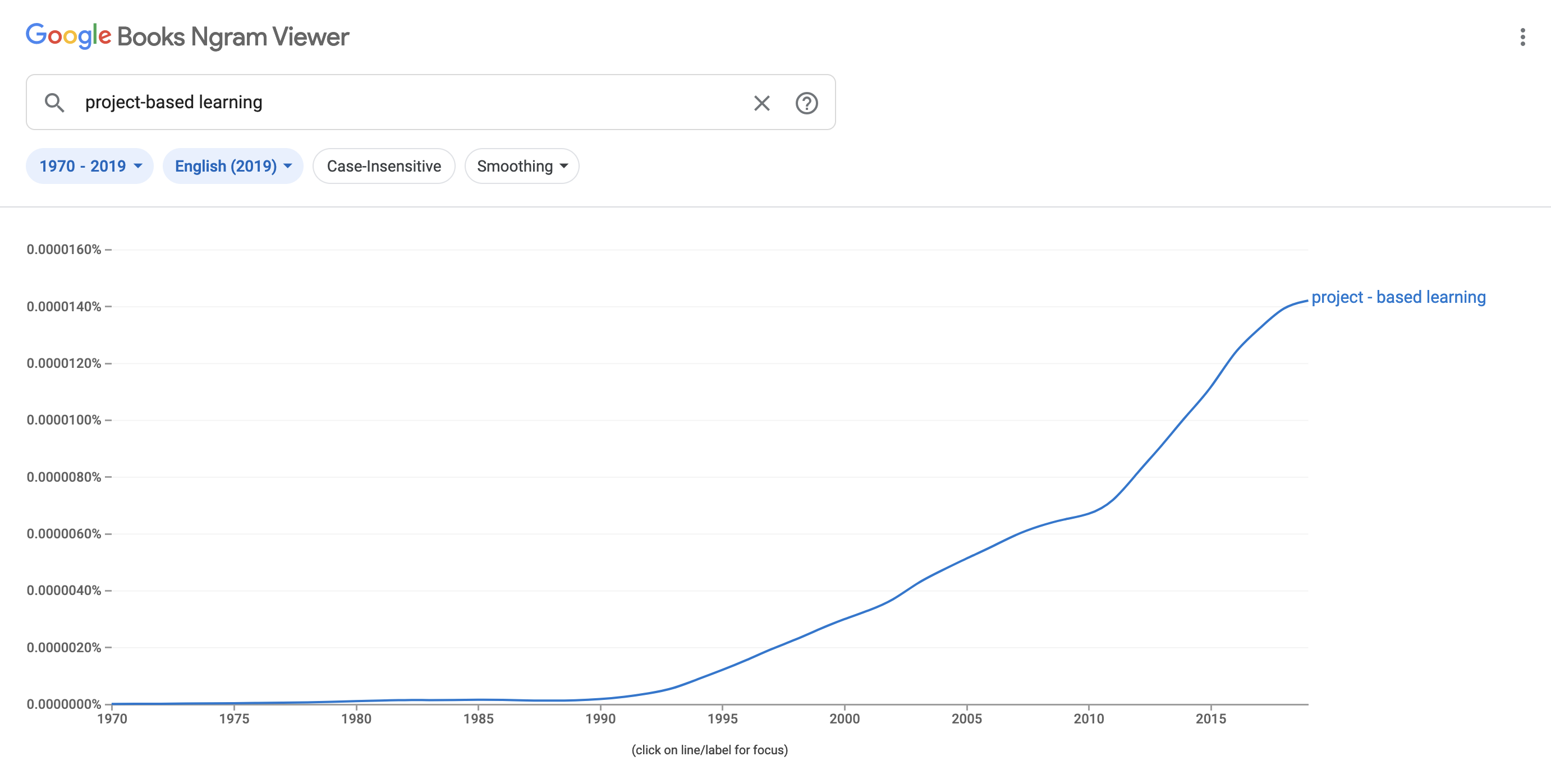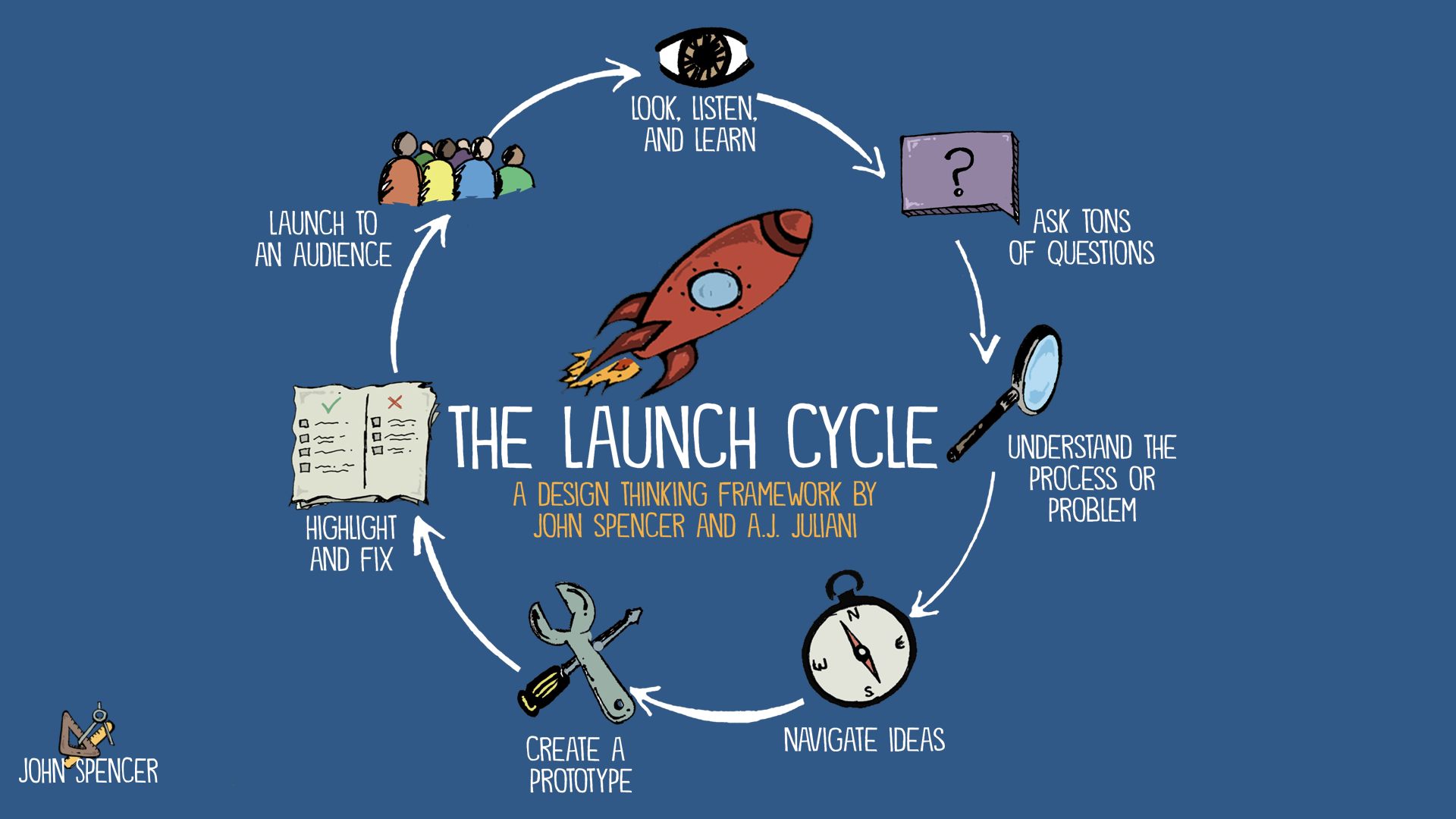PBL by Design – Exploring the Overlap of Project-Based Learning and Design Thinking
Education Rethink 2022-04-06
Project-based learning and design thinking have both become buzzwords in the educational landscape. But beyond the buzz, both PBL and design thinking have rich histories that span decades. Both approaches also offer practical frameworks for teachers who are crafting authentic projects for their students. So, what exactly is the relationship between PBL and design thinking? When and how should we use each approach? Is either option better for our students? In this article, we explore what it means to find the overlap between PBL and design thinking by treating project-based learning as the pedagogical framework and design thinking as the creative framework.
 Listen to the Podcast
Listen to the Podcast
If you enjoy this blog but you’d like to listen to it on the go, just click on the audio below or subscribe via Apple Podcasts (ideal for iOS users) or Google Play and Stitcher (ideal for Android users).
https://spencerauthor.com/wp-content/uploads/2022/04/PBL-by-Design.mp3
Empowering Students with Voice and Choice
What happens when teachers design projects that empower students with voice and choice? Students embrace a maker mindset. They define themselves as inventors and creators. They learn to take creative risks. Here they experiment and engage in iterative thinking. When this happens, they embrace a growth mindset and grow resilient. They become problem solvers and systems thinkers. They become divergent thinkers — thinking outside the box. They use creative constraint to find original uses for materials. Here, they discover it’s okay to be different. Often students embrace curiosity and wonder. They become explorers seeking out new information and thinking critically. They grow more empathetic as they design meaningful products that they launch to the world.
On an academic level, students are more engaged and the information sticks. There’s often an increase in student achievement. Meanwhile, they learn key skills like project management, collaboration, and communication. True, these projects will prepare students for the creative economy. But more importantly, they empower students for a creative life. Here, they see that making is magic. We know that there’s a time crunch in schools. Materials can be scarce. Sometimes you’re stuck with a tight curriculum map. But when you, as a teacher, empower your students with voice and choice, they become the makers who change the world.
But how do we make the most out of project-based learning when we have tight time deadlines, a set of standards to teach, and limited resources? One solution is to combine project-based learning with design thinking. You can think of PBL as a pedagogical framework and design thinking as a creative framework. When this happens, you end up with PBL by Design. It’s an idea I explore in my latest sketch video:
{"@context":"http:\/\/schema.org\/","@id":"https:\/\/spencerauthor.com\/pbl-by-design\/#arve-youtube-mmyke0-finy624cbd2eea3bd665945245","type":"VideoObject","embedURL":"https:\/\/www.youtube-nocookie.com\/embed\/mmYKE0-FINY?feature=oembed&iv_load_policy=3&modestbranding=1&rel=0&autohide=1&playsinline=0&autoplay=0"}
Before taking a deeper dive into the overlap, let’s look at project-based learning and design thinking separately.
PBL is the Pedagogical Framework
Project-based learning isn’t exactly a new concept. In fact, no one is entirely sure where and when project-based learning began. Suzie Boss ties it back to Confucius, Aristotle, and Socrates. Others see the roots of PBL in Rousseau in Emile. Elements of PBL emerge in John Dewey’s (1897) notion of learning through projects and later Heard Kilpatrick’s 1908 “project method,” However, there are also strong elements of PBL (authentic audience, learning by doing, inquiry-based learning) that have existed in vocational education and trade schools as well.
According to Google’s Ngram tool, which tracks the frequency of terms within published materials, the phrase “project-based learning” first grew in popularity in the early 1990’s and has continued to increase over the last few decades. This suggests that PBL is more than a mere fad. Yes, it’s gaining in popularity, but it has been decades in the making.

With the rise of automation, artificial intelligence, and machine learning, many schools have sought out project-based learning as a way to develop essential soft skills, like collaboration, communication, creativity, problem-solving, information literacy, and global citizenship. Project-based learning offers a way to develop these critical skills while also mastering the content at a deeper level. There’s some fascinating new research about how authentic PBL can lead to increases in academic achievement.
Project-based learning isn’t a formal learning theory. Instead, it fits within the broader category of constructivism and perhaps even connectivism. It’s more of a pedagogical framework, because it’s a different way of crafting and organizing our lessons. The following video is a quick primer on project-based learning as a pedagogical framework.
{"@context":"http:\/\/schema.org\/","@id":"https:\/\/spencerauthor.com\/pbl-by-design\/#arve-youtube-crmm4z3okmq624cbd2eeb420554672039","type":"VideoObject","embedURL":"https:\/\/www.youtube-nocookie.com\/embed\/crMM4z3oKmQ?feature=oembed&iv_load_policy=3&modestbranding=1&rel=0&autohide=1&playsinline=0&autoplay=0"}
However, despite the popularity of project-based learning, the term can seem a little nebulous. For one, it’s easy to get confused between project-based learning, problem-based learning, and inquiry-based learning because each model seems to include a challenge, a finished product, and sustained inquiry. Moreover, there are many different project-based learning models. Many teachers prefer the PBL Works Gold Standard Model but I actually prefer the High Quality Project Based Learning Model. Still, others prefer various PBL models developed by foundations, higher education institutes, and even businesses. If you’re new to PBL, you might want to explore different models and see what works best for your classroom setting. Honestly, there’s a lot of overlap between most models.
While each project-based learning model is different, the following are some common components within the models:
- a provocation, challenge, or question
- student inquiry
- authenticity, with a focus on connecting to the community
- student-led investigations that lead to internal construction of knowledge
- student voice and choice in the process and the finished product
- student self-direction at an individual and small group level
- meaningful collaboration with built-in interdependence within the group
- project management
- student reflection throughout the process
- ongoing peer feedback and revision
- a public product
Note how different this approach can feel different compared to more traditional pedagogical frameworks. Often, PBL will involve key paradigm shifts that we, as educators, need to make. This includes a shift from culminating projects to a system where students learn through the projects. In other words, you don’t do a traditional unit plan and end in a project. Instead, students discover the content through the project. Another shift toward student choice in the design of the projects and away from highly detailed project instructions. Students engage in meaningful inquiry rather than using pre-planned questions. It often involves a shift from the teacher as the director of learning to the teacher as a facilitator.
Sometimes it helps to ask, “What am I already doing that’s similar to PBL?” You might be doing culminating projects that could be transformed into a full PBL unit. You might have authenticity but you could add more student choice to the inquiry and research phases. For me, project management was one of the last components that I added. For the first few years of PBL, I managed all the projects. Eventually, I realized that students needed to own the project management process.
Design Thinking is the Creative Framework
Design thinking is a human-centered approach to creative problem-solving. It is used in the arts, in engineering, in the corporate world, and in social and civic spaces. Like PBL, it’s a bit of a debate where design thinking originated. Some claim that it started in the sixties with The Sciences of the Artificial. Others point to Design Thinking, which focused more on urban planning and architecture. Still others point to Robert McKim’s work in Experiences in Visual Thinking. Like all great ideas, it has been an evolution, influenced by thousands of people. We know that our work around Design Thinking has been influenced by people like Tom and David Kelley, Tim Brown, John Maeda, Peter Rowe (as well as organizations like Stanford d.school and IDEO). For a great primer on the history of design thinking, check out Jo Szczepanska‘s article with the interactive timeline. She actually ties it back to Buckminster Fuller’s notion of design science and the Scandinavian movement of cooperative design.The key thing here is that that design thinking exists in so many different domains, meaning it is easy to connect to all subject areas in school.
While there are many design thinking models, A.J. Juliani and I realized the need for a student-friendly design thinking framework tailored specifically for a K-12 environment. We both had spent over a decade using design thinking and we had each added a few innovations, including an inquiry phase, a research phase, and a launch phase. After testing this out in multiple classrooms, we finalized the LAUNCH Cycle.
 It starts with Look, Listen, and Learn. The goal here is awareness. It might be a sense of wonder a process, an understanding of a problem, an observation of a natural phenomenon, or an awareness of a social issue. But it also includes empathy with a community. Sparked by curiosity, students move to the second phase, where they ask tons of questions, which leads to understanding the process or problem through an authentic research experience. They might do needs assessments, conduct surveys, watch videos, listen to podcasts, conduct experiments, make observations, analyze data, do a video chat with an expert or engage in online research. Students apply the newly acquired knowledge to potential solutions. In this phase, they navigate ideas. Here they not only brainstorm, but they also analyze ideas, combine ideas, and generate a concept for what they will create. From there, they Create a Prototype, whether it’s a digital work, a physical product, a service, a system, or an event. Next, they Highlight What’s Working and Fix What’s Failing. Here, they view the revision process as an experiment full of iterations where every mistake takes them closer and closer to success. Then, when it’s done, it’s ready to launch to an audience. In this launch phase, they send their work to the world. Then, based on the audience feedback, they move into a new iteration, where they’re able to Look, Listen, and Learn all over again.
It starts with Look, Listen, and Learn. The goal here is awareness. It might be a sense of wonder a process, an understanding of a problem, an observation of a natural phenomenon, or an awareness of a social issue. But it also includes empathy with a community. Sparked by curiosity, students move to the second phase, where they ask tons of questions, which leads to understanding the process or problem through an authentic research experience. They might do needs assessments, conduct surveys, watch videos, listen to podcasts, conduct experiments, make observations, analyze data, do a video chat with an expert or engage in online research. Students apply the newly acquired knowledge to potential solutions. In this phase, they navigate ideas. Here they not only brainstorm, but they also analyze ideas, combine ideas, and generate a concept for what they will create. From there, they Create a Prototype, whether it’s a digital work, a physical product, a service, a system, or an event. Next, they Highlight What’s Working and Fix What’s Failing. Here, they view the revision process as an experiment full of iterations where every mistake takes them closer and closer to success. Then, when it’s done, it’s ready to launch to an audience. In this launch phase, they send their work to the world. Then, based on the audience feedback, they move into a new iteration, where they’re able to Look, Listen, and Learn all over again.
The Overlap of PBL and Design Thinking
When I first started out on my project-based learning journey, I followed a loosely structured PBL model. This particular model avoided using specific phases in a project and instead focused on ideas like authenticity, sustained inquiry, and reflection. While I loved the approach, I noticed that students still struggled with creative work. I realized that I needed a framework that included specific phases or stages in the design process. I wanted students to engage in authentic projects in a way that mirrored the design process in the real world.
This is ultimately why I embraced design thinking. It’s a process that focuses on empathy and awareness; working to understand on a profound level the problems people are facing before attempting to come up with ideas and create solutions. It is a slower, deeper approach that encourages research and revision. Unlike PBL, design thinking includes specific phases or stages in a project. This can add the necessary structure missing from certain project-based learning experiences.
At the same time, project-based learning provides the pedagogical model needed for design thinking. With PBL, we have key competencies, necessary protocols, and certain design elements we can use as we craft lesson plans. If I attempt to use design thinking but fail to incorporate PBL, students will not learn the content in as deep of a level. In other words, PBL provides the elements for the learning process but design thinking provides elements for the creative process.
So if we want to use both frameworks, how do actually do it? A great starting place is to ask if the project-based learning experience works with design thinking. Some PBL projects might work better with the engineering process, the inquiry process, an open-ended independent process (think Genius Hour), or the Scientific Method. Design thinking tends to work well when you have an authentic audience where you can center the project on student empathy. If design thinking works well for your PBL, then you can start planning it out.
You might want to organize your project according to the design thinking phases. Here, you plan out each phase of the project to connect with each phase in the design thinking process. Next, you can use project-based learning as a checklist of specific components you will need throughout the project. For example, ask yourself, “Is this actually authentic?” or “Do students have voice, choice, and self-direction here?” The following table demonstrates what this overlap looks like.
Design Thinking ElementsPBL ElementsPBL by DesignLook, Listen, and LearnA provocation, challenge, or question Authenticity, with a focus on connecting to the communityIn this Look, Listen, and Learn phase, students begin with a challenge or question centered on a specific community. This is authentic starting point directly relates to the community and often includes empathy.Ask Tons of QuestionsStudent inquiry Student-led investigations that lead to internal construction of knowledge Student voice and choice in the process and the finished productIn this Ask Tons of Questions phase, students develop specific driving questions, research questions, and essential questions. They might do a PBL-specific Knows / Needs to Know structure. Here, they begin the inquiry process with voice and choice about which questions they want to answer.Understand the Process or ProblemStudent inquiry Authenticity, with a focus on connecting to the community Student-led investigations that lead to internal construction of knowledge Student voice and choice in the process and the finished product Student reflection throughout the process Student self-directionIn this Understand the Process or Problem phase, the focus is on student inquiry. Here students engage in student-driven, authentic research that connects to the community. They might do needs assessments, conduct interviews with experts, or do surveys. Here, they should have a voice in what questions they ask, what questions they answer, and how they organize their research. Note that these student-led investigations help students to internally construct knowledge. As teachers, we can improve this by embedding moments of self-refection.Navigate IdeasAuthenticity, with a focus on connecting to the community Student voice and choice in the process and the finished product Student self-direction Interdependent collaborationAfter students have developed deeper background knowledge, they Navigate Ideas. Here, they have choice in the brainstorming and planning of their project. This is the start of the deeper project management process. Teachers can embed structures for interdependent decision-making in this phase.Create a PrototypeAuthenticity, with a focus on connecting to the community Student voice and choice in the process and the finished product Project management Student reflection throughout the process Student self-directionWhen students Create a Prototype, they work interdependently in collaborative groups. Often, the group will have one key project manager to keep the whole group on schedule. This phase tends to be highly self-directed at the small group and individual level.Highlight and FixAuthenticity, with a focus on connecting to the community Student voice and choice in the process and the finished product Project management Ongoing peer feedback and revision Student reflection throughout the process Student self-directionStudents use ongoing peer feedback and revision as they Highlight and Fix. While the focus is on improving the product, they also engage in self-reflection on the process as well. The goal here is student ownership and self-direction of the revision process.Launch to the WorldAuthenticity, with a focus on connecting to the community Student voice and choice in the process and the finished product A public product Student reflection throughout the process Student self-directionStudents determine their audience and their marketing strategy as they Launch to the World. The goal is a public product in a way that is truly authentic.As you plan out specific lessons, you might include protocols from PBL (including Driving Questions, Need to Know, Project Management) but also design thinking (A Day in the Life, Needs Assessment, Challenge Assumptions). The first attempt might be a little clunky but that’s okay. The more you blend the two together, the more you will notice that these two frameworks merge together really well. Ultimately, when we combine PBL and design thinking, it leads to better projects and deeper learning.
Get Your Free PBL Blueprint and Resources

Get this free PBL Blueprint along with a members-only access to a free PBL resource each week for the next 4 months!
Success! Now check your email to get the toolbox!
There was an error submitting your subscription. Please try again.
The post PBL by Design – Exploring the Overlap of Project-Based Learning and Design Thinking appeared first on John Spencer.